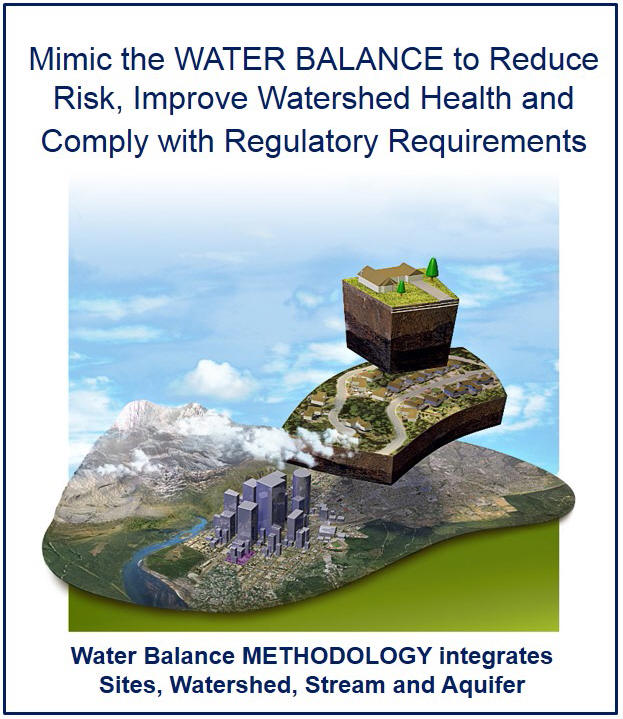FLASHBACK TO 2014: “When reading the Primer on Water Balance Methodology for Protecting Watershed Health, it is helpful to reflect on the historical context to understand that the water balance approach had its genesis in the Stream Stewardship Series,” stated Erik Karlsen, formerly an Executive Director in the BC Ministry of Municipal Affairs
Note to Reader:
The “Beyond the Guidebook Primer Series” supports implementation of targets and actions listed in Living Water Smart: British Columbia’s Water Plan. The targets and actions establish expectations as to how land will be (re)developed so that stream and watershed health are protected and/or restored.
The Primer on Water Balance Methodology for Protecting Watershed Health is the fifth in a series of guidance documents that form the basis for knowledge-transfer via the Georgia Basin Inter-Regional Education Initiative (IREI). The foundation document for the series is Stormwater Planning: A Guidebook for British Columbia, released in 2002.
The goal in producing the “Beyond the Guidebook Primer Series” is to facilitate inter-regional collaboration, such that sharing and cross-fertilization of experience and understanding helps all local governments go farther, more efficiently and effectively.
The Goal: Mimic Natural Water Balance and Protect Water Quality
“When the natural environment is altered by human activities, the slow-release and sponge-like functions of vegetation and soil are lost, such that the balance and flow of water are severely upset,” explains Kim Stephens, Executive Director of the Partnership for Water Sustainability, and principal author of British Columbia’s Stormwater Guidebook.
 “Protection of watershed and stream health ultimately involves maintaining the natural proportion of rainwater entering streams via three pathways: surface flow, interflow (shallow sub-surface flow), and groundwater flow.”
“Protection of watershed and stream health ultimately involves maintaining the natural proportion of rainwater entering streams via three pathways: surface flow, interflow (shallow sub-surface flow), and groundwater flow.”
“This desired outcome is described as ‘mimicking the natural Water Balance’. Performance targets define how to ‘slow, sink and spread’ rainwater and thereby replicate natural processes.”
“The fifth in the Beyond the Guidebook Primer Series provides guidance on how to apply the Water Balance Methodology and quantify three performance targets, namely: storage volume, infiltration area and flow release rate.”
“When reading the Primer, it is helpful to take a step back and view the Water Balance Methodology in an historical context. In a nutshell, the methodology is a pragmatic outcome of a ‘design with nature’ guiding philosophy that had its genesis more than two decades ago when British Columbia and Canada co-published the Stewardship Series.”
Building on the Stream Stewarship Series
“Released circa 1993, Stream Stewardship: A Guide for Planners and Developers document was an early, and in some respects the first, local government focussed design with nature guide,” recalls Erik Karlsen, formerly an Executive Director in the BC Ministry of Municipal Affairs.
 “Looking back over the past 20-plus years, if the Stewardship Series was the first wave, the work of UBC’s James Taylor Chair on Sustainable Urban Landscapes was the second, and the Water Balance Approach is the third.”
“Looking back over the past 20-plus years, if the Stewardship Series was the first wave, the work of UBC’s James Taylor Chair on Sustainable Urban Landscapes was the second, and the Water Balance Approach is the third.”
“Each of these ‘waves’ was initiated by different ‘groups’ focussing on different aspects of stream stewardship issues; but over time they shared members, and merged from one to the other,” concludes Erik Karlsen.
More than Surface Runoff
 “Defining how much water can be retained, infiltrated, and detained on a lot is a completely different way of looking at the drainage problem and solutions. Surface runoff is a small component of natural watershed function. The key to replicating watershed function and mitigating impacts is understanding ALL flow paths through the landscape. Then, Watershed-based Targets can be distilled into a set of design values that are easily applied at a lot level,” explains Jim Dumont, the Partnership’s Engineering Applications Authority.
“Defining how much water can be retained, infiltrated, and detained on a lot is a completely different way of looking at the drainage problem and solutions. Surface runoff is a small component of natural watershed function. The key to replicating watershed function and mitigating impacts is understanding ALL flow paths through the landscape. Then, Watershed-based Targets can be distilled into a set of design values that are easily applied at a lot level,” explains Jim Dumont, the Partnership’s Engineering Applications Authority.
“The Water Balance Methodology provides a logical and straightforward way to assess potential impacts resulting from urban development; and analytically demonstrate the effectiveness of the methods proposed for preventing and/or mitigating those impacts.”
To Learn More:
To download a copy, click on Primer on Water Balance Methodology for Protecting Watershed Health. The Primer storyline is structured in five parts:
- Part A: Watershed-Based Approach to Rainwater Management
- Part B: Water Balance Methodology Explained
- Part C: Science Behind the Methodology
- Part D: How to Establish Targets
- Part E: References
For a synopsis of each part, click on the following link to Table 1. Information is presented in a layered fashion to accommodate the interests of a continuum of audiences.



